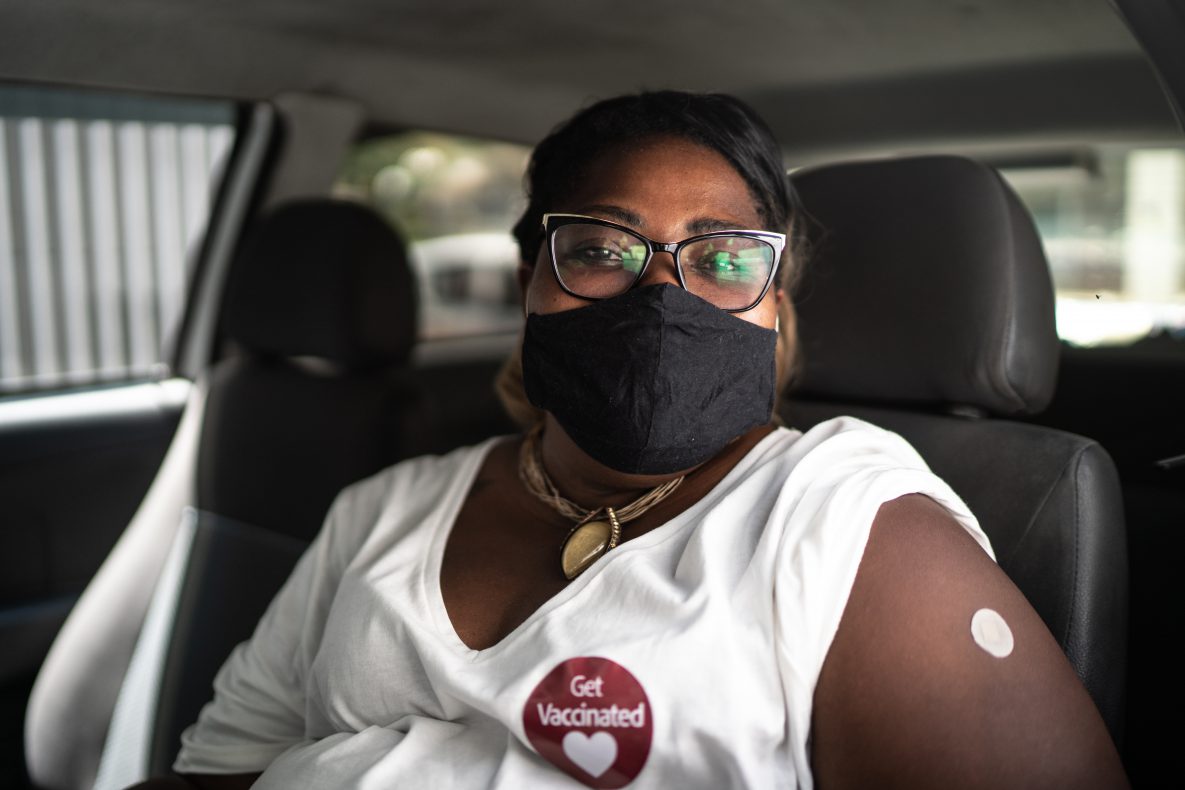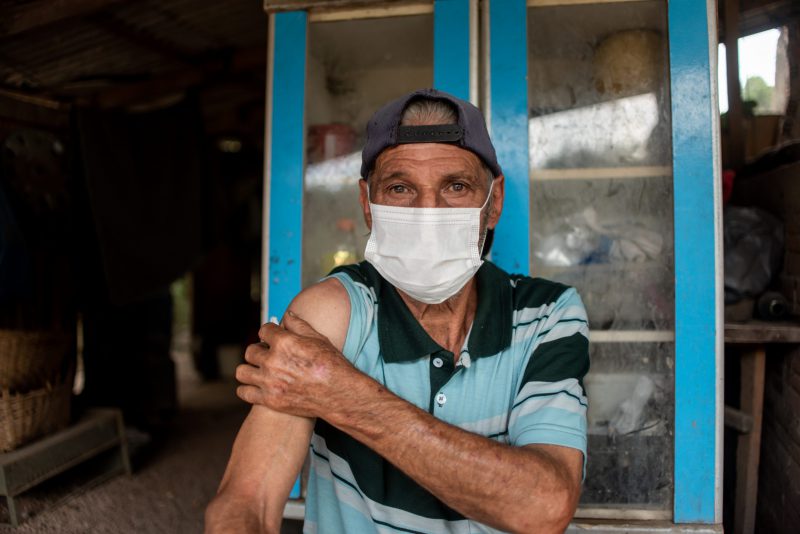COVID-19 Vaccine Equity for Racial and Ethnic Minority Groups


CDC is committed to COVID-19 vaccine equity, which is when everyone has fair and just access to COVID-19 vaccination. There are many social, geographic, political, economic, and environmental factors that create challenges to vaccination access and acceptance, and that often affect racial and ethnic minority groups. Some of these factors include:
- Education, income, and wealth gaps
- Job access and working conditions
- Racism and other forms of discrimination
- Gaps in healthcare access
- Transportation and neighborhood conditions
- Lack of trust as a result of past medical racism and experimentation
Because of these and other challenges, some Black or African American people and Hispanic or Latino people are less likely to be vaccinated against COVID-19 than people in other racial and ethnic minority groups and non-Hispanic White people.[1-3] You can view the most current race and ethnicity data on COVID-19 vaccination. In addition to being less likely to get a vaccine, Black or African American people and Hispanic or Latino people are more likely to get seriously ill and die from COVID-19 due to the factors listed above.[4-6] CDC uses the Social Vulnerability Index (SVI) to assess the potential negative effects on communities caused by external stresses on human health. You can view the most current health equity data on COVID-19.
Other racial and ethnic minority groups, including American Indian or Alaska Native people, have also been more severely affected by COVID-19 than non-Hispanic White people, due to the challenges listed above. However, vaccination rates among American Indian or Alaska Native people were among the highest earlier in the pandemic among racial and ethnic minority groups, [7] in part due to vaccination efforts from CDC and partners. Regardless, the gains early on can be lost if the follow up requirements are not sustained. Efforts to maintain sufficient up-to-date vaccination must be responsive to community needs. You can find more information about CDC COVID-19 activities in Tribal communities, including vaccination efforts, and communication resources.
CDC Is Committed to Vaccine Equity for Racial and Ethnic Minority Groups
CDC is paving the way in vaccine equity efforts with national, state, tribal, territorial, local, and community partners to ensure that Black or African American people and Hispanic or Latino people have fair and just access to COVID-19 vaccination. To support vaccine equity, CDC continues to communicate with and listen to all communities affected by COVID-19. CDC is working to build trust, increase collaboration, and create tools and resources to respond to the concerns and feedback from all communities affected by COVID-19, especially those disproportionately impacted. These activities, along with messages supported by science, can help to increase COVID-19 vaccine acceptance and make it easier to get vaccinated.
Communication and Educational Resources
You can use the resources below to engage with communities that have been affected by COVID-19. Many of the resources available can be tailored for racial and ethnic minority communities to:
- Help build vaccine confidence
- Share clear and accurate information to educate about COVID-19
- Raise awareness about the benefits of vaccination and address common questions and concerns
- Adapt key messages to the language, tone, and format that will resonate with communities
- Understand community needs regarding COVID-19 vaccines
COVID-19 Vaccines for Children and Teens: Resources for parents and caregivers to help find COVID-19 vaccines for children and information about COVID-19 vaccination for children 5 years and older.
COVID-19 Vaccination for Children 5-11 Years Old: Information for providers, jurisdictions, and partners planning vaccination of children, clinical research, and information for children with developmental disabilities.
A Guide for Community Partners—Increasing COVID-19 Vaccine Uptake Among Racial and Ethnic Minority Communities: A resource for community organizations to engage in or support COVID-19 vaccination confidence and access in racial and ethnic minority communities. Explore strategies, interventions, and ready-made messages and materials. This document is also available in Spanish.
COVID-19 Vaccination Toolkit for Health Departments and Other Public Health Partners and Community-Based Organizations Vaccine Toolkit: Include key messages and community engagement strategies that build trust and educate communities about COVID-19 vaccines.
Communication Toolkit for Migrants, Refugees, and Other Limited- English-Proficient Populations: Prevention and vaccination messaging for public health professionals, health care providers, and community organizations to reach communities that speak languages other than English.
Rapid Community Assessment Guide: Resources for state and local health departments to identify communities at risk for low COVID-19 vaccine uptake and understand community needs regarding COVID-19 vaccination.
COVID-19 Vaccination for Essential Workers: Racial and ethnic minority groups are disproportionately represented among essential work and industries. This page includes resources for employees and employers to help plan for and encourage COVID-19 vaccination to protect the workplace.
CDC has printable resources covering a wide range of topics related to COVID-19 vaccines that can be filtered by audience.
- Facts About COVID-19 Vaccines: General information about COVID-19 vaccines. Available in 27 languages.
- What to Expect after Getting a COVID-19 Vaccine: Information on what to expect after getting a COVID-19 vaccine. Available in 10 languages.
- A Safe and Effective COVID-19 Vaccine is Now Available: Comic-book style graphic fotonovela that tells the story of a daycare worker’s decision to get vaccinated against COVID-19. Available in English, Spanish, and Haitian Creole.
CDC Partnerships and Funding
Health and vaccine equity are essential parts of CDC’s mission. CDC works with national, state, tribal, territorial, local, and community partners to promote COVID-19 vaccination among Black or African American people and Hispanic or Latino people. To support these partnerships, CDC has provided funding for organizations that reach racial and ethnic minority groups. This funding includes:
- $3 billion awarded to 64 jurisdictions to support local health departments and community-based organizations in launching new programs and initiatives to increase vaccine access, acceptance, and uptake in communities disproportionately impacted by COVID-19
- $2.25 billion awarded to health departments across the United States and its territories to work in collaboration with community partners to support efforts to address COVID-19 health disparities
- $348 million to organizations for community health worker (CHW) services to support COVID-19 prevention and control, and $32 million to organizations for CHW services to support training, technical assistance, and evaluation, all funded through the CDC’s Community Health Workers for COVID Response and Resilient Communities initiative.
Additional CDC efforts toward vaccine equity for racial and ethnic minority groups include funding for:
- 8 national organizations through CDC’s Partnering with National Organizations to Increase Vaccination Coverage Across Different Racial and Ethnic Adult Populations Currently Experiencing Disparities, including: Asian and Pacific Islander American Health Forum, National Alliance for Hispanic Health, National Minority Quality Forum, National Urban League, Northwest Portland Area Indian Health Board, National Council of Negro Women, UnidosUS, Conference of National Black Churches
- 4 medical organizations serving racial and ethnic minority groups through CDC’s Partnering with Professional and Medical Associations to Increase Vaccination Coverage Across Different Racial and Ethnic Adult Populations Experiencing Disparities, including: National Medical Association, National Hispanic Medical Association, Association of American Indian Physicians, National Council of Urban Indian Health
- 3 national foundations through CDC’s Partnering with National Organizations to Support Community-Based Organizations to Increase Vaccination Coverage Across Different Racial and Ethnic Adult Populations Currently Experiencing Disparities, including: CDC Foundation, Community Catalyst, Urban Institute
- 34 national, state, tribal, and community organizations through CDC’s Racial and Ethnic Approaches to Community Health – REACH, including: Alaska Native Tribal Health Consortium, Allegheny County, PA, American Heart Association, California Department of Public Health, Cicatelli Associates, Inc., City of Hartford, CT, City of Miami Gardens, FL, City of San Antonio Metropolitan Health District, TX, City of Worcester, MA, County of San Diego, Health and Human Services Agency, CA, Cuyahoga County Board of Health, Dekalb County Board of Health, GA, Eastern Michigan University, Health and Hospital Corporation of Marion County, Health Partners Initiative DBA Partnership for a Healthy Lincoln, NE, Houston County Board of Health, TX, Leadership Council for Healthy Communities, Lowell Community Health Center, Mississippi Public Health Institute, Montgomery Area Community Wellness Coalition, AL, Multnomah County Health Department, National Kidney Foundation of Michigan, Partners in Health, Penn State Health Milton S. Hershey Medical Center, Pima County Health Department, AZ, Presbyterian Healthcare Services, Public Health Advocates, Rosedale Assistance & Opportunities, Seattle-King County Public Health Department, WA, Southern Nevada Health District, The Institute for Family Health, University of Arkansas for Medical Sciences, YMCA of Coastal Georgia
Through these and other partnerships, CDC is working to remove barriers to COVID-19 vaccination access and promote vaccine equity. In line with this effort, CDC works with the Federal Retail Pharmacy Program to conduct community-based activities and use data to ensure COVID-19 vaccines are accessible in all communities.
Because of the availability of COVID-19 vaccines, the nation is closer than ever to ending the COVID-19 pandemic in the United States. Yet challenges remain in ensuring all people have fair and just access to COVID-19 vaccination. CDC is committed to ongoing work to promote vaccine equity.
Resources on COVID-19 and Health Equity
CDC Health Equity Resources
Other Resources
- Emory University’s COVID-19 Health Equity Interactive Dashboard
- Morehouse School of Medicine, Satcher Health Leadership Institute’s Health Equity Tracker
- National Academy of Medicine’s Resources on Health Equity in the Context of COVID-19 & Disproportionate Outcomes for Marginalized Groups
Footnotes
- Khubchandani, J., & Macias, Y. (2021). COVID-19 Vaccination Hesitancy in Hispanics and African-Americans: A Review and Recommendations for Practice. Brain, behavior, & immunity-health, 100277.
- Baack, B. N., Abad, N., Yankey, D., Kahn, K. E., Razzaghi, H., Brookmeyer, K, et al. (2021). MMWR—COVID-19 vaccination coverage and intent among adults aged 18–39 years—United States, March–May 2021.
- Kricorian, K., & Turner, K. (2021). Covid-19 vaccine reluctance in older Black and Hispanic adults: Cultural sensitivity and institutional trust. Journal of the American Geriatrics Society, S214-S214.
- Romano, S. D. (2021). Trends in racial and ethnic disparities in COVID-19 hospitalizations, by region—United States, March–December 2020. MMWR. Morbidity and mortality weekly report, 70.
- Mackey, K., Ayers, C. K., Kondo, K. K., Saha, S., Advani, S. M., Young, S. et al. (2021). Racial and ethnic disparities in COVID-19–related infections, hospitalizations, and deaths: a systematic review. Annals of internal medicine, 174(3), 362-373.
- Mude, W., Oguoma, V. M., Nyanhanda, T., Mwanri, L., & Njue, C. (2021). Racial disparities in COVID-19 pandemic cases, hospitalizations, and deaths: A systematic review and meta-analysis. Journal of Global Health, 11.
- CDC COVID Data Tracker Vaccination Demographics Trends